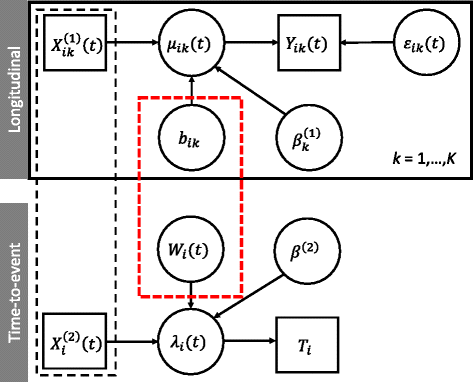Joint modelling of time-to-event and multivariate longitudinal outcomes: recent developments and issues
- PMID: 27604810
- PMCID: PMC5015261
- DOI: 10.1186/s12874-016-0212-5
Joint modelling of time-to-event and multivariate longitudinal outcomes: recent developments and issues
Abstract
Background: Available methods for the joint modelling of longitudinal and time-to-event outcomes have typically only allowed for a single longitudinal outcome and a solitary event time. In practice, clinical studies are likely to record multiple longitudinal outcomes. Incorporating all sources of data will improve the predictive capability of any model and lead to more informative inferences for the purpose of medical decision-making.
Methods: We reviewed current methodologies of joint modelling for time-to-event data and multivariate longitudinal data including the distributional and modelling assumptions, the association structures, estimation approaches, software tools for implementation and clinical applications of the methodologies.
Results: We found that a large number of different models have recently been proposed. Most considered jointly modelling linear mixed models with proportional hazard models, with correlation between multiple longitudinal outcomes accounted for through multivariate normally distributed random effects. So-called current value and random effects parameterisations are commonly used to link the models. Despite developments, software is still lacking, which has translated into limited uptake by medical researchers.
Conclusion: Although, in an era of personalized medicine, the value of multivariate joint modelling has been established, researchers are currently limited in their ability to fit these models routinely. We make a series of recommendations for future research needs.
Keywords: Joint models; Longitudinal data; Multivariate data; Software; Time-to-event data.
Figures

References
-
- Cox DR. Regression models and life-tables. J R Stat Soc Ser B Stat Methodol. 1972;34:187–220.
-
- Rizopoulos D. Joint Models for Longitudinal and Time-to-Event Data, with Applications in R. Boca Raton: Chapman & Hall/CRC; 2012.
MeSH terms
Grants and funding
LinkOut - more resources
Full Text Sources
Other Literature Sources

